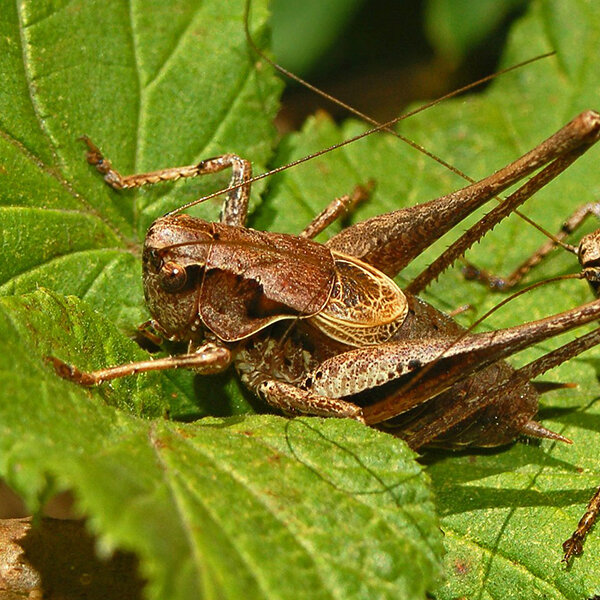Dark Bush-cricket
Pholidoptera griseoaptera
The dark bush-cricket can be found in woodlands, hedgerows, bramble thickets, and gardens throughout summer. They are common and the noisy chirpings are a familiar sound of late summer. They can often be seen in quite large numbers.
Dark bush-crickets measure 11-21 mm in length and are dark to reddish-brown in colour, with a paler patch along the top of the thorax and a yellow-green belly. The hindlegs are very long, the forewings are very small (almost wingless), and they have very long antennae. The female has an up-curved ovipositor which is used to lay eggs in late summer.
Eggs are laid into rotting wood or crevices in bark, nymphs appear at the end of April, and adults can be seen in late June/early July and survive until November/December.
The call is a brief penetrating high-pitched chip that can be heard throughout the day and into the night. It is sung from low vegetation at irregular intervals.
What they eat
They feed on a wide range of vegetation and small insects.
Where and when to see them
Dark bush-crickets can be seen from May to November.
They often bask in sunshine on vegetation, but will hide if disturbed. Creep-up slowly to get a good view.
Identify them using the stridulation (call).
View a dark bush-cricket 10km distribution map of Wales.
Legal status
None
Similar species
Grey bush-cricket (Platycleis albopunctata)
As its name suggest, the grey bush-cricket is greyish-brown in colour, and has full length wings and a central keel on the rear of the pronotum. It is a medium sized bush-cricket measuring up to 28mm in length. The call of the grey bush-cricket is soft and rapidly repeated. This species is omnivorous eating both plants and small insects. It is more of a coastal species found mainly in southern England and South Wales.
Bog bush- cricket (Metrioptera brachyptera)
This bush-cricket measures around 11-21 mm, and has medium length wings that do not reach the tip of the abdomen. It has a central keel on the rear side of the pronotum. Green or brown in colour, but with a bright green underside. Also has a cream-coloured band on the hind-edge of the pronotom. The song is a soft but shrill-like buzz (almost like a rapidly ticking watch). As its name suggests, this cricket favours damper habitats such as damp heath or moorland.
Roesel’s bush-cricket (Metrioptera roeselii)
Roesel’s bush-cricket has medium length wings that do not reach the tip of the abdomen. It has a broad pale margin around the side plates of the pronotum, and has three yellow spots on the sides of the thorax. It is a medium sized cricket measuring around 13-26mm. This cricket has a distinctive high pitched song lasting for a minute or longer, and sounds similar to the crackle of electricity power cables. This species was recently only recorded in the south-eastern part of Britain but is now rapidly expanding its range and is now found in South Wales.
Did you know?
Whilst the sound of a grasshopper or cricket is called a song, the noise is actually made by stridulation where two parts of the insect are rubbed together to produce a unique sound. Male dark bush-crickets make two kinds of chirps – a mating call to attract females and another call to warn off rival males. You can use a bat detector to hear the songs of grasshoppers and crickets more clearly.


